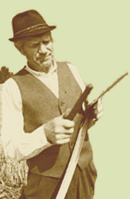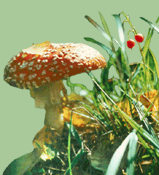Lichen seemingly one, but actually two
Ave Suija introduces lichenized fungi: some fungi combined with algae become lichens, while the same fungus without an alga exists as a normal fungus. Lichens have been considered as strange plants without leaves, trunks or roots. These exiting organisms have attracted scientists for centuries, but have deserved little attention in Estonian Nature. Systematically lichens belong to the Kingdom of Fungi. The cover story features these mysterious organisms thoroughly, explaining the symbiosis between fungi and algae and how the different types of partnerships are generated and developed.
Estonian Nature enquires
Tanel Tiirats writes about limitations to the use of motor vehicles in protected areas.
Peep Mardiste gives a short overview of the work of an environmental councilor in Brussels.
Mires protect water
Hella Kink writes about a simple and well-known fact which, however, seems to be ignored by those who drain the mires. Mires function as generation and preservation areas for water, and their role lies also in maintaining natural water balance. Therefore, the drainage of mires affects environment on a larger scale. Mires should also be protected as natural monuments, and the author exemplifies this claim with numerous examples of different mires, starting from those located on karst areas to those on uplands and dunes. Currently, 116 mires have been listed as natural monuments in the Book of Estonian Primeval Nature.
Fungi at our homes 1. Microfungi or mould fungi
Kalle Pilt, Helle Järv and Jane Oja warn against fungi that sometimes become too comfortably settled at our homes. The article features three groups of mould fungi that are related to dwellings. Most attention is paid to the so-called black mould that prefers new building materials and that can cause health problems to humans and animals. The authors also describe the effect of mould fungi on the interiors of building and list the needs of such fungi.
Tiny human associates: Silverfish and others
Mati Martin describes lively insects, one of them probably familiar from the bathroom floor.
The silverfish is a small, wingless insect from the insect order Thysanura. The species is estimated to have existed for 300 million years, originating in the Palaeozoic Era. The favourite food of silverfish is any matter that contains starch or polysaccharides. These include glue, book bindings, paper, photos, sugar, hair, and dandruff. Silverfish can also cause damage to books, tapestries, and textiles. Silverfish will commonly graze in and around showers, baths and sinks on the cellulose present in many shampoos, shaving foams and so on. Silverfish and other house-dwelling arthropods prefer high temperatures and high humidity.
Kurese Landscape Protection Area
Urmas Vahur, the master and servant of the Kurese village, takes a glance into the long history and the sad presence of the village. Kurese landscape protection area is situated in the northen part of the Pärnu County, centered around the Mihkli Salumägi (a former nature protection area) as an important site of alvars. The aim of the newly founded larger protected area is to protect heritage landscapes as well as the Kibura karst field, protected species and communities. The detailed article gives an interesting overview of the sites in the area, their history and presence.
European rarities in Estonia: the beetle Cucujus cinnaberinus
Ilmar Süda warns forest owners: the felling of old aspen forests may cause the loss of an important beetle species - Cucujus cinnaberinus. This pretty red beetle is rare everywhere in Europe, and there are only three known small populations identified in Estonia. The species prefers old-growth mixed forests with aspens, since its larvae are developed on dead or slightly decayed aspen trunks.
Interview: Spiritual growth replaces economic growth
Henri Laupmaa has interviewed Jakob von Uexküll, a Green thinker and environmentalist from Germany.
Hiking trail: Sunsets and bog landscapes in Meenikunno
Arvi Lepisk takes the reader to a mire protection area, a place well-known to many nature lovers. The hiking trail is 2.4 km long and has become even too popular destination for hikes, picnics and open-air parties. The article describes the main natural sights in the Meenikunno area.
The Kalametsa canyon
Tapio Vares suggests visiting a wonder of nature in North Latvia, near Mehkamaa. It is the Kalametsa canyon cut in the Devonian limestone along the Polistupe River. Such magnificent canyon seems impossible; it has to be witnessed with ones own eyes.
Dunlin
Sven Zaèeks camera has caught a bird that is mostly migratory in Estonia.
Halophileous sea kale
Urmas Kokassaar makes a difference between a similar-named alga and flowering plant, although both are edible. The Estonian merikapsas mostly refers to the vascular plant Crambe maritima, sometimes also to green algae Ulva lactuca and Ulva fasciata. The curent article focuses on sea kale, its different features and possible use in our diet.
Mushrooming with books
Erast Parmasto helps to find a way among the many books published in recent years for those who go mushroom-picking. There are 19 books (and more are coming) of different levels that help those interested in mushrooms.
| 

![[IN ENGLISH]](images/gb.gif)





